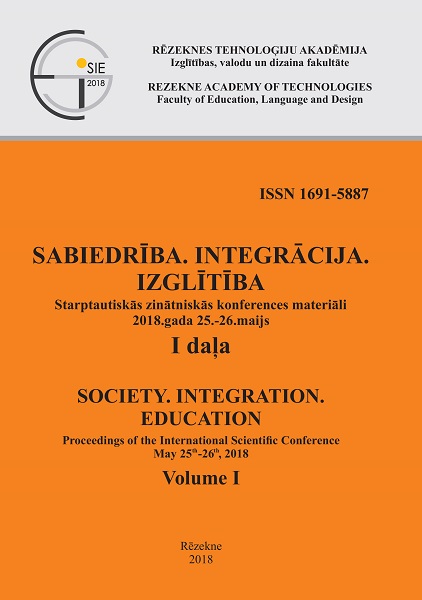WHY DO YOU WANT ME TO LEARN CONNECTIVELY BUT TEST ME INDIVIDUALLY? SOCIALLY EMBEDDED LEARNING AT THE UNIVERSITY
DOI:
https://doi.org/10.17770/sie2018vol1.3245Keywords:
Connectivism, higher education, mind maps, networking, social mediaAbstract
Connectivism concept introduced by George Siemens seems to be accurate when considering current-learning processes in higher education. The author emphasises the role of socially embedded learning that can take place out of human bodies, in devices. The main aim of this work was to analyse students’ and academic teacher’s experiences related to cooperating through a network and creating mind maps as a result of learning in the frame of the conducted course at the University. The data was collected during the course through Mentimeter tool, which enabled the author to learn students’ opinions, reflections and associations related to the process of working on electronic mind maps. Students were also asked to write reflective essays where they described their experiences associated to the mind map that were significant from the perspective of learning at the University. The results of the analysis were presented below.
References
Bielinis, L. (2017). FB, they and me – the attempts of using social media as tools for reflective learning and communicating at the University. Proceedings of the International Scientific Conference May 26th-27th, Volume 1.. 46-62.
Buzan, T. (1984). Use your head. London: Guild Publishing.
Czachorowski, S. (2016, November 2). Ryślenie, czyli myślograficznie i lapbookowo. Edunews.pl. Retrieved from: https://www.edunews.pl/narzedzia-i-projekty/narzedzia-
edukacyjne/3649-ryslenie-czyli-myslograficznie-i-lapbookowo
Downes, S. (2012). Connectivism and connective knowledge. Essays on meaning and
learning networks. [Adobe Reader]. Retrieved from:
https://pdfs.semanticscholar.org/4718/ee3c1930820e094552f0933cbc3b86548dbc.pdf
Gardner, H., Davis, K. (2013). The App Generation. How today’s youth navigate their
Identity, intimacy and imagination in a digital world, New Heaven and London: Yale University Press.
Huth, A. G., de Heer, A., Griffiths, T. L., Theunissen, F. E., Gallant, J. L. (2016). Natural speech reveals the semantic map that tile human cerebral cortex. Nature, vol. 532,
-473.
Jones, Ch., Shao, B. (2011). The Net Generation and Digital Natives. Implications for Higher Education. [Adobe Reader]. Retrieved from: http://oro.open.ac.uk/30014/
Konecki, K. (2000). Studia z metodologii badań jakościowych. Warszawa: Wydawnictwo Naukowe PWN.
Konarzewski, K. (2000). Jak uprawiać badania oświatowe. Metodologia praktyczna. Warszawa: Wydawnictwa Szkolne i Pedagogiczne Spółka Akcyjna.
Kyles, C. R., Olafson, L. (2008). Uncovering Preservice Teachers’ Beliefs About Diversity Through Reflective Writing. Urban Education, 43 (5), 500-518. Retrieved from: http://uex.sagepub.com
Mizerek, H. (2017). Ewaluacja edukacyjna. Interdyskursywne dialogi i konfrontacje, Kraków: Oficyna Wydawnicza “Impuls”.
Prensky, M. (2001). Digital Natives, Digital Immigrants. On the Horizon, 9 (5), 1-15. Retrieved from: http://dx.doi.org/10.1108/10748120110424816
Siemens, G. (2005). Connectivism: A learning theory for the Digital Age. International
Journal of Instructional Technology and Distance Learning, Vol. 2 No. 1, 3-10.
Sperry, R. W. (1975). Left-Brain, Right-Brain. Saturday Review, 9/8/75, 30-33.
Spitzer, M. (2016). Cyfrowa demencja. W jaki sposób pozbawiamy rozumu siebie i swoje dzieci, Słupsk: Wydawnictwo Dobra Literatura.
Strelau, J. (2003). Psychologia. Podręcznik akademicki, t. 1 – Podstawy psychologii. Gdańsk: Gdańskie Wydawnictwo Psychologiczne.
Ziółkowska, B. (2005). Okres wczesnej dorosłości. Jak rozpoznać potencjał młodych dorosłych? In: A. I. Brzezińska (Eds.), Portrety psychologiczne człowieka. Praktyczna psychologia rozwojowa (pp. 423-468). Gdańsk: Gdańskie Wydawnictwo Psychologiczne.






